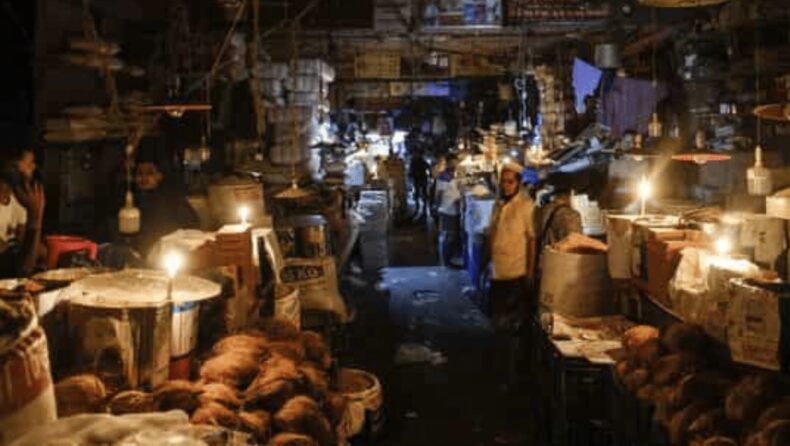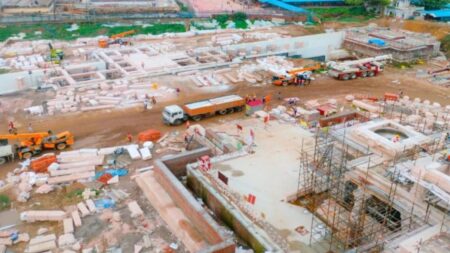Electricity supply restored after the country plunged into a blackout following the failure of its national power grid.
A national power grid failure in Bangladesh has left around 140 million people across the country without electricity since Tuesday afternoon.
The blackout, which impacted much of the country, started at 2.05 p.m. on October 4 and lasted for nearly seven hours before power was completely restored at 9 p.m. It was not immediately clear what caused the glitch.The Bangladesh national power grid failed and caused nationwide blackout with the exception of parts of northern Bangladesh, reported Dhaka Tribune newspaper.

“The transmission line tripped somewhere in the eastern part of the country…Following the grid failure, all power plants tripped one after another and electricity supply went off in Dhaka, Chittagong, Sylhet, Barisal, and Mymensingh divisions,” reported The Tribune.
“To cope with the (power) crisis, we have been using generators. Today’s outage was unpredictable. We had to shut our offices,” because generators cannot run for long periods, Shahidullah Azim, Vice President of the Bangladesh Garment Manufacturers and Exporters Association said.
The association represents members that have more than 4,500 garment factories nationwide. Bangladesh is the world’s second-biggest garment exporter after China.
Zunaid Ahmed Palak, a junior minister in Bangladesh, said on Facebook it was “risky to restore (power) with a heavy load”.
The load on the power grid generally increases in the evenings in Bangladesh, when citizens return home after work. Demand growth in the recent years has largely been driven by the residential segment.
“If the stability of the system is fairly satisfactory, the power lines of all area of Dhaka will be activated. We sincerely apologise for the inconvenience,” Palak said.

Telecom operator association of Bangladesh
The Association of Mobile Telecom Operators of Bangladesh said on Tuesday mobile and internet services may be disrupted in some parts of the country due to the national power grid failure.
Many large shopping malls in the capital, Dhaka, closed early on Tuesday evening. Elsewhere, people gathered at fuel stations to collect diesel to run standby generators and market vendors operated amid candlelight.
Nasul Hamid, junior Minister for Power, Energy and Mineral Resources, said in a statement that he regretted the “temporary inconvenience” caused by the power failure. Officials at the state-run Bangladesh Power Development Board earlier said power transmission had failed in the eastern part of the country.
Over a third of the country’s 77 gas-powered units were short of fuel, government data showed on Tuesday.
The diesel-run power plants produced about 6 percent of Bangladesh’s power generation, so their shutdowns cut output by up to 1500 megawatts.
Garment factories hit by Bangladesh powergrid failure
Earlier this month, Faruque Hassan, president of the Bangladesh Garment Manufacturers and Exporters Association, said that the situation is so serious that garment factories are without power now for about four to 10 hours a day. Bangladesh is the world’s second-largest garment exporter after China, and it earns more than 80% of its total foreign currency from exports of garment products each year.
Operations at Bangladesh’s lucrative export-oriented garment industry, which supply to clients such as Walmart (WMT.N), Gap Inc (GPS.N), H&M (HMb.ST), VF Corp (VFC.N), Zara and American Eagle Outfitters (AEO.N) were hit by the power outage on Tuesday.”To cope with the (power) crisis, we have been using generators. Today’s outage was unpredictable. We had to shut our offices,” because generators cannot run for long periods, Shahidullah Azim, Vice President of the Bangladesh Garment Manufacturers and Exporters Association said.

The association represents members that have more than 4,500 garment factories nationwide. Bangladesh is the world’s second-biggest garment exporter after China.
“We can’t run factories without power,” Azim added.
Zunaid Ahmed Palak, a junior minister in Bangladesh, said on Facebook it was “risky to restore (power) with a heavy load”.
Last month, the Asian Development Bank said in a report that Bangladesh’s economic growth would slow to 6.6 percent from its previous forecast of 7.1 percent in the current fiscal year.
PGCB pannel start probe into national grid failure
An investigation committee of the state-owned Power Grid Company of Bangladesh (PGCB) started its probe on Wednesday to identify the reasons behind the national power grid failure that triggered a 7–8-hour long blackout across most of the country from 2:04pm on Tuesday.
“We started our probe this morning to identify the possible causes behind the national grid disaster and also the exact point of the incident,” Yakub Elahi Chowdhury, chief of the investigation body and executive director (P&D) of the PGCB, told UNB.
The PGCB initially formed a five-member investigation committee, headed by Yakub Elahi Chowdhury, representatives from the Bangladesh Power Development Board (BPDB), Bangladesh University of Engineering and Technology (Buet), and also from other power sector entities, following the national grid failure.“It might take more time to reach a conclusion as this involves a lot of technical issues of the grid system,” Yakub told UNB.Meanwhile, State Minister Nasrul Hamid instructed the ministry of power, energy and mineral resources to form two more investigation committees to identify the cause of the grid failure and also gave recommendations to avert any further disasters in the future.
GCB and BPDB officials believe that Tuesday’s grid disaster started from somewhere in the Ashuganj-Sirajganj interconnecting transmission line that led to a colossal shutdown of power plants across the country.













